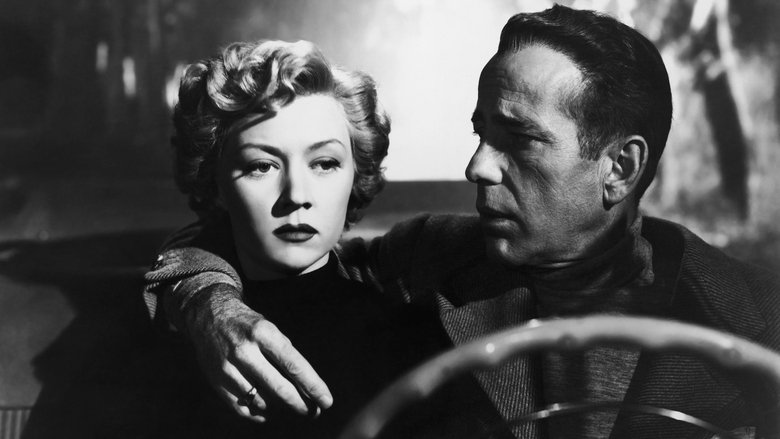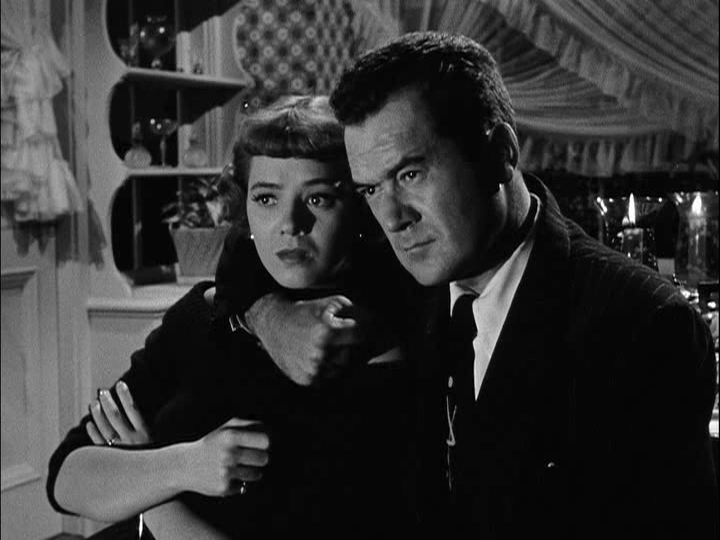← Back to Reviews

in
In a Lonely Place
A classic from 1950, In a Lonely Place is a sizzling psychological melodrama that rivets the viewer to the screen thanks to a rich story, colorful characters, and the off-the-charts chemistry between the stars.

Humphrey Bogart stars as Dixon Steele, a down-on-his-luck screenwriter who has been given the chance to revive his career by turning a new book into a viable screenplay. Steele meets a young hat check girl who has just read the book and instead of reading the book himself, he invites her back to his apartment to tell him about the book. After they finish, Steele gives the girl cab fare and tells her there's a cab stand around the corner. A few hours later, a cop friend of Steele's shows up at his door and informs him that the girl has just been found brutally murdered.

While trying to convince the police that he had nothing to do with this murder, Steele begins his new screenplay with the assistance of his attractive upstairs neighbor, Laurel Gray (Gloria Grahame) who agrees to do the typing for him. Steele and Laurel fall hard for each other but Laurel finds it hard to stay loyal to Steele as he comes into focus as the prime suspect in this murder, due to the reveal of Steele's past, which includes a propensity for violent behavior, and it's not all in the past either.

Director Nicholas Ray and screenwriter Andrew Solt really score here, mounting a story that creates doubt on the screen for our tortured protagonist for the viewer. The story makes it pretty clear that Steele is innocent, but things start occurring during the course of the story that this reviewer actually began to doubt whether or not Steele is actually innocent, which I'm pretty sure was the intent here...the scene where Steele goes to dinner at his cop buddy's house and forces him and his wife to act out how he thinks the murder happened was undeniably creepy and was an effective red herring provided by Solt to remind the viewer that all may not be as it seems.

The casting of Bogart in the role of Steele was also inspired because Bogey's stone-face hides so much here...we're never sure exactly what this guy is thinking and trying to predict what he was going to do next became impossible. There's a scene where Steele beats a guy to a pulp after a minor traffic infraction that I didn't see coming at all. Scenes like this made it very understandable when even Laurel began doubting Steele's innocence.

Ray must also be credited with the rich performance he gets from Bogey and the positively steamy chemistry created between him and leading lady Grahame, whose performance as Laurel is electric sex on legs. Frank Lovejoy was effective as Steele's cop buddy as was Robert Warwick as a boozy alcoholic actor-buddy of Steele's. The film also deserves a shout out for George Anthiel's quirky music. A severely underrated winner from a very good year for the movies that defines "film noir.'
A classic from 1950, In a Lonely Place is a sizzling psychological melodrama that rivets the viewer to the screen thanks to a rich story, colorful characters, and the off-the-charts chemistry between the stars.

Humphrey Bogart stars as Dixon Steele, a down-on-his-luck screenwriter who has been given the chance to revive his career by turning a new book into a viable screenplay. Steele meets a young hat check girl who has just read the book and instead of reading the book himself, he invites her back to his apartment to tell him about the book. After they finish, Steele gives the girl cab fare and tells her there's a cab stand around the corner. A few hours later, a cop friend of Steele's shows up at his door and informs him that the girl has just been found brutally murdered.

While trying to convince the police that he had nothing to do with this murder, Steele begins his new screenplay with the assistance of his attractive upstairs neighbor, Laurel Gray (Gloria Grahame) who agrees to do the typing for him. Steele and Laurel fall hard for each other but Laurel finds it hard to stay loyal to Steele as he comes into focus as the prime suspect in this murder, due to the reveal of Steele's past, which includes a propensity for violent behavior, and it's not all in the past either.
Director Nicholas Ray and screenwriter Andrew Solt really score here, mounting a story that creates doubt on the screen for our tortured protagonist for the viewer. The story makes it pretty clear that Steele is innocent, but things start occurring during the course of the story that this reviewer actually began to doubt whether or not Steele is actually innocent, which I'm pretty sure was the intent here...the scene where Steele goes to dinner at his cop buddy's house and forces him and his wife to act out how he thinks the murder happened was undeniably creepy and was an effective red herring provided by Solt to remind the viewer that all may not be as it seems.

The casting of Bogart in the role of Steele was also inspired because Bogey's stone-face hides so much here...we're never sure exactly what this guy is thinking and trying to predict what he was going to do next became impossible. There's a scene where Steele beats a guy to a pulp after a minor traffic infraction that I didn't see coming at all. Scenes like this made it very understandable when even Laurel began doubting Steele's innocence.

Ray must also be credited with the rich performance he gets from Bogey and the positively steamy chemistry created between him and leading lady Grahame, whose performance as Laurel is electric sex on legs. Frank Lovejoy was effective as Steele's cop buddy as was Robert Warwick as a boozy alcoholic actor-buddy of Steele's. The film also deserves a shout out for George Anthiel's quirky music. A severely underrated winner from a very good year for the movies that defines "film noir.'
